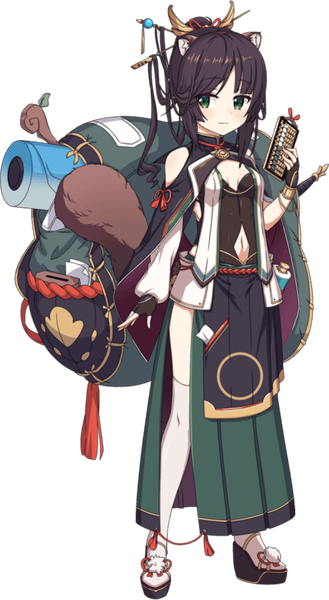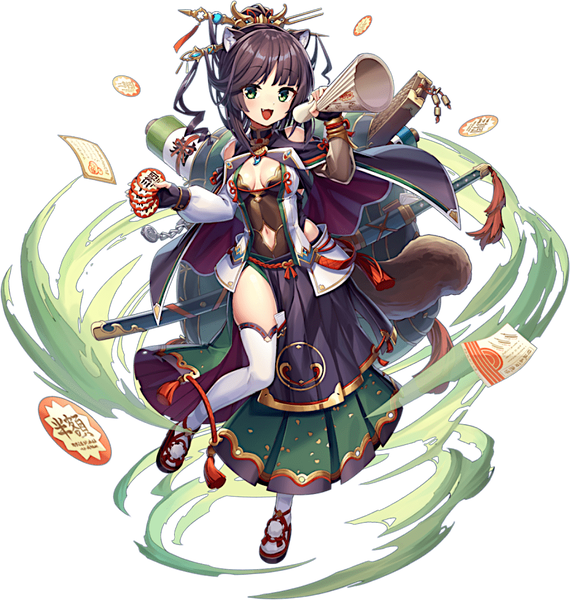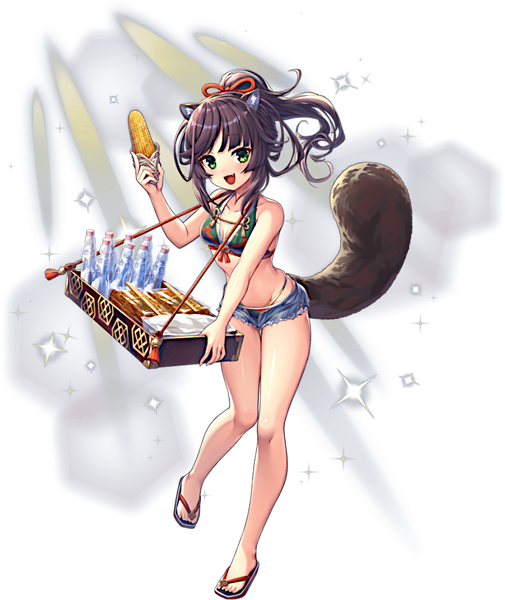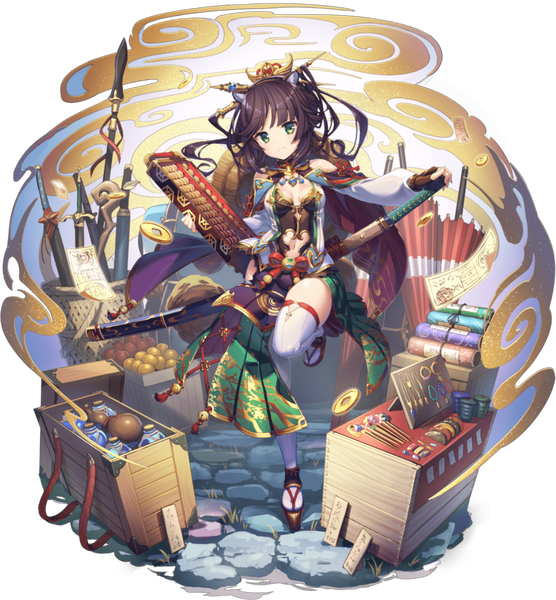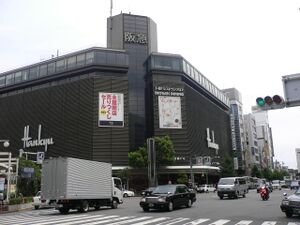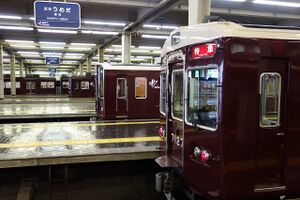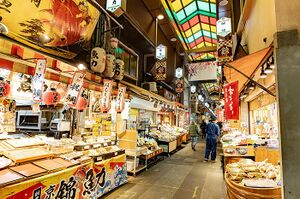Karamachi
| Karamachi | |||||
|---|---|---|---|---|---|
| Japanese Name | カラマチ | ||||
| Weapon | |||||
| Race | Beast | ||||
| Nationality | |||||
| Birthday | June 17 | ||||
| Constellation | Gemini | ||||
| Talents | Appraising antiques, Fiddling with machines | ||||
| Likes | Junk, Machinery, Fu manju | ||||
| Dislikes | Violence | ||||
| Strengths | Open-minded about everything | ||||
| Weaknesses | Indecisive | ||||
| Hobbies | Repairing broken items, Renovating | ||||
Welcome, I'm Karamachi the shopkeep dosu~. I have been a part of the Train Knights for a long time now, but I've now accepted to join the SSS as an official member of the Train Knights~. I'm not the biggest fan of fightin', but I'll do my best to help you all out~.
Layers
| Icon | Title | Release Date | Where to Obtain |
|---|---|---|---|
| [General Shopkeeper] Karamachi | 2021 October 1 | [Welcome to the Booby Trap House] Event Reward | |
| [Karamachi Shop Special Sale Day!] Karamachi | 2022 November 24 | [Downtown Oyabun and the Royal Opera Knight] Limited Gacha | |
| [Merchant by the Waves] Karamachi | 2023 July 21 | [All-Out Summer! Polar Bear Floats and Water Guns] Limited Gacha | |
| [Delivering Memories] Karamachi | 2021 September 30 | 1st Anniversary Limited Gacha 3 |
Skills
Profile
Karamachi is a well-known merchant in Nishiki, first introduced early in the Nishiki-saga, notable for her slow speech and Kansai-dialect. Karamachi sells wares that are very rare and cannot be found anywhere else. She can be seen in the Shop tab on the main menu.
Main Story
| Story Arc 1 |
|---|
|
She appears to have ears and tail, but Vivienne and Putra noticed that something's unusual about Karamachi's ears very early on. However, their questions were ignored and they were not able to press more about it at the time. It was later revealed in the Giant Tree Strategy Saga that Karamachi had been serving the Mistism cult as a spy to obtain secret information from the SSS since the very beginning, and it is why the Mistism cult is able to promptly track any activities from the SSS army, making them a threat. She was their spy because of the cult's false promises of her cure - cure of her affliction without her ears and tail, and believing that she's abandoned by the Beast Goddess of Nishiki. She sought aid and was taken in by the Mistism cult as a follower. The cult granted her safety and promised in return that she can get her ears and tail back should she aid them. Karamachi was afflicted with the curse of the Mist, as such she has lost her ears and tail as a beastkin. This means that Karamachi is unable to access Nishiki shaman magic unique to Nishiki beastkin. In return however, she has the unusual ability to be completely immune to the effects of the Mist. Mist monsters lurking inside the Mist completely ignore whatever she is doing while inside, making her unharmed. This allows her to find lost artifacts, antiques and valuables within the Mist, allowing her to restock for her business, as well as having uninhibited access to spy on the SSS's whereabouts. After the reopening of the St. Iris Giant Tree train station, Karamachi denounced the Mistism cult and prevented one of the cult leaders from capturing Conductor, and in response she was held hostage by said leader and demands the Conductor to comply. Not wanting Karamachi to get killed, Conductor agreed to follow the cult leader to the altar, and the leader was later killed by Mary in an ambush. Karamachi was later arrested for her crimes of espionage and is sent to Oshioki Prison, albeit the sentence is lightened for her desertion from the Mistism cult and her attempts to alert and protect the Conductor and the SSS team. |
Trivia
- Karamachi's birthday is the opening date of Kawaramachi Station in 1963, before renaming to Kyoto-Kawaramachi station.
- Karamachi's beast motif is the Japanese raccoon dog, also known as the tanuki. Within Japanese folklore, the tanuki have had a significant role since ancient times. The legendary tanuki are reputed to be mischievous and jolly, masters of disguise and shapeshifting but somewhat gullible and absentminded. This also fits with her role as a spy and as a member of the Mistism cult.
- Karamachi speaks in Kansai dialect, which is native to real life Kyoto. Unlike the stereotypical "rapid-fire Kansai" seen in most Japanese media however, Karamachi speaks unusually slowly.
- Karamachi's merchant design is likely a reference to the Nishiki Market (錦市場) in downtown Kyoto, a shopping district centered on food sales that has a 1300-year history since the Heian period. In Mist Train Girls, Karamachi is the main shopkeeper of the country of Nishiki, and is a representative of the Shop Menu in-game.
- Karamachi's occupation as a merchant also fits with her tanuki motif, as it is a lucky charm of business prosperity (also cons). The theme also fits her counterpart, Kyoto-kawaramachi Station as a commercial center.
- Karamachi's favourite fu manju, (麩饅頭) is a Kyoto local wheat gluten treat stuffed with sweet red bean paste and steamed inside a fresh bamboo leaf. The dough is fresh with a distinctive chewy texture.
- Karamachi [General Shopkeeper] is the only A-rarity layer that is a Raid Event Layer.
- Karamachi's [Memories Delivered] introduction is the longest in the game when obtained, clocking in at 54 seconds.
Counterpart
Kyoto-kawaramachi Station (京都河原町駅) is the terminal station of the Hankyu Kyoto Main Line of Hankyu in Kyoto City, Japan. The Kawaramachi and Shijo streets cross over the underground station. Gion-Shijo Station on the Keihan Main Line is located beyond the Kamo River.
This station opened as Kawaramachi Station on June 17, 1963; it was renamed to Kyoto-kawaramachi Station on October 1, 2019 to make it easier for domestic and foreign tourists to understand that this station is the main station of Kyoto City. Before the opening of Kawaramachi Station and Karasuma Station, the Hankyu Kyoto Main Line terminated at Ōmiya Station. The station is sometimes called "Shijo-Kawaramachi Station" as it is located directly under the Shijo Kawaramachi intersection where Shijo Dori and Kawaramachi Dori intersect. The station was formerly connected to the basement of the now-defunct department store named Shijo Kawaramachi Hankyu.
The area around the station (Shijō Kawaramachi) is one of the commercial centers of Kyoto. The real estate around the station is the most valuable in Kyoto. The station is attached underground to department stores such as Takashimaya, which has a food market on its basement floor. The station also connects underground to Karasuma Station. The underground station is an island-style platform with three lines on one side. There is a notched line 2 in the direction of Osaka (Umeda) on line 3. There are two ticket gates, the east ticket gate and the central ticket gate.
This underground station has three island-type platforms, with Line No. 2 cut out for the Osaka (Umeda) side of Line No. 3. There are two ticket gates, the east ticket gate and the central ticket gate. In addition, there used to be a west ticket gate directly connected to the platform of Line 2, but it has been used only during the daytime since March 18, 2001, and was closed on March 16, 2007, the day before the timetable revision on March 17, 2007. Restrooms are located at the east end of the platform, and a multifunctional type is also provided. The station is manned by a stationmaster, who is in charge of the stations from this station to Nishimugaoka Station, as well as other stations on the Ranzan Line. Wikipedia
Nishiki Market (錦市場, literally "brocade market") is a marketplace in downtown Kyoto, located on the east end of Nishikikōji Street, one block north and parallel to Shijō Street (四条通) and west of Teramachi Street (寺町通). Rich with history and tradition, the market is renowned as the place to obtain many of Kyoto's famous foods and goods.
As early as the year 782 the sale of fish started in the area, thanks to the cold groundwater available at the site, which made possible to keep fish and other meats fresh in a location close to the Kyoto Imperial Palace. In 1615, for the first time the place officially received official permission from the Bakufu government to conduct the sale of fish, being this the first step for becoming a renowned market it is today. After the Meiji Restoration of 1883, due to the strong competition between establishments the number or shops was reduced to only 7.
In 1911, a new association promoting the market as a place for the sale of fish and seafood As a result, the market saw a renewed vitality, much later the Central Wholesale Market of Kyoto opened and many stores moved there from the Nishiki Market from 1927 onwards. A new association promoted the opening of shops offering fruits, vegetables, meats and other food products on the following year. This marks the point from where the market began to be known as "Kyoto’s kitchen". Redesigns in 1984 added the current cobblestone floor and in 1993 the current arcade canopy was installed. Wikipedia
Map
Gallery
- Pages using Tabber parser tag
- Pages using DynamicPageList3 parser tag
- Weapon Sword
- Beast
- Nishiki
- Gemini
- Element Cut
- Element Light
- Element Fire
- Element Wind
- Train Knights
- Mistism
- Japan

